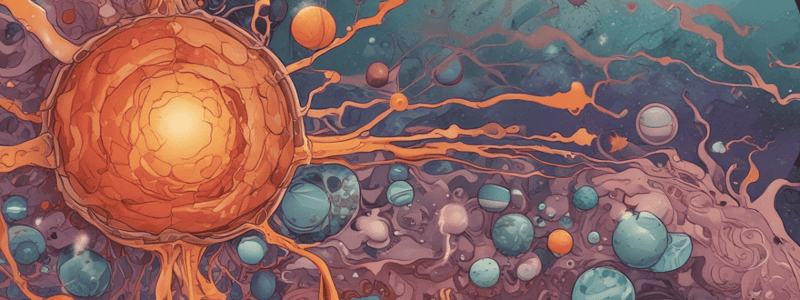Podcast
Questions and Answers
What are the two staging systems used to classify the progression of Chronic Lymphocytic Leukemia (CLL)?
What are the two staging systems used to classify the progression of Chronic Lymphocytic Leukemia (CLL)?
Rai Staging System and Binet Staging System
What is the primary purpose of the watchful waiting approach in treating CLL?
What is the primary purpose of the watchful waiting approach in treating CLL?
Monitoring symptoms and blood counts
What is the primary mechanism of action of Ibrutinib, a targeted therapy used to treat CLL?
What is the primary mechanism of action of Ibrutinib, a targeted therapy used to treat CLL?
Inhibits BTK enzyme
What is the significance of the 17p deletion genetic mutation in CLL?
What is the significance of the 17p deletion genetic mutation in CLL?
What is the primary purpose of a bone marrow biopsy in the diagnosis of CLL?
What is the primary purpose of a bone marrow biopsy in the diagnosis of CLL?
What is the role of Rituximab in the treatment of CLL?
What is the role of Rituximab in the treatment of CLL?
What are the three primary factors that affect the prognosis of CLL?
What are the three primary factors that affect the prognosis of CLL?
What is the purpose of immunophenotyping in the diagnosis of CLL?
What is the purpose of immunophenotyping in the diagnosis of CLL?
What is the primary benefit of autologous stem cell transplantation in CLL?
What is the primary benefit of autologous stem cell transplantation in CLL?
What is the significance of anemia in the staging of CLL?
What is the significance of anemia in the staging of CLL?
Flashcards are hidden until you start studying
Study Notes
Symptoms
- Fatigue
- Weight loss
- Recurring infections
- Enlarged lymph nodes
- Enlarged liver or spleen
- Easy bruising or bleeding
- Frequent infections
- Rash or skin lesions
- Swollen or painful abdomen
Stages
- Rai Staging System:
- Stage 0: CLL cells in blood and bone marrow only
- Stage I: Enlarged lymph nodes
- Stage II: Enlarged spleen
- Stage III: Anemia
- Stage IV: Low platelet count
- Binet Staging System:
- Stage A: No anemia or thrombocytopenia
- Stage B: Anemia or thrombocytopenia
- Stage C: Anemia and thrombocytopenia
Prognosis
- Median survival: 5-10 years
- Factors affecting prognosis:
- Age: Older patients have poorer prognosis
- Stage: Advanced stages have poorer prognosis
- Genetic mutations: Certain mutations (e.g. 17p deletion) have poorer prognosis
- Treatment response: Patients responding to treatment have better prognosis
Treatment Options
- Watchful waiting: Monitoring symptoms and blood counts
- Chemotherapy:
- Chlorambucil
- Fludarabine
- Cyclophosphamide
- Targeted therapy:
- Ibrutinib (inhibits BTK enzyme)
- Idelalisib (inhibits PI3K delta enzyme)
- Immunotherapy:
- Rituximab (targets CD20 protein)
- Stem cell transplantation: Autologous or allogenic transplantation
- Clinical trials: Investigational treatments, such as CAR-T cell therapy
Diagnosis
- Blood tests:
- Complete Blood Count (CBC)
- Peripheral blood smear
- Immunophenotyping (flow cytometry)
- Bone marrow biopsy:
- Bone marrow aspiration
- Bone marrow biopsy
- Imaging studies:
- CT scans
- PET scans
- Ultrasound
- Lymph node biopsy: Excisional biopsy of enlarged lymph nodes
Symptoms of Chronic Lymphocytic Leukemia (CLL)
- Fatigue is a common symptom of CLL
- Weight loss is often associated with CLL
- Recurring infections occur due to the impaired immune system
- Enlarged lymph nodes, liver, or spleen can be a sign of CLL
- Easy bruising or bleeding is a result of low platelet count
- Frequent infections are a consequence of the weakened immune system
- Rash or skin lesions may appear in some cases
- Swollen or painful abdomen can occur due to enlarged spleen or liver
Rai Staging System for CLL
- Stage 0: CLL cells are present only in the blood and bone marrow
- Stage I: Enlarged lymph nodes are present
- Stage II: Enlarged spleen is present
- Stage III: Anemia is present
- Stage IV: Low platelet count is present
Binet Staging System for CLL
- Stage A: No anemia or thrombocytopenia is present
- Stage B: Anemia or thrombocytopenia is present
- Stage C: Both anemia and thrombocytopenia are present
Prognosis of CLL
- Median survival rate is 5-10 years
- Older patients have a poorer prognosis
- Advanced stages of CLL have a poorer prognosis
- Presence of certain genetic mutations (e.g. 17p deletion) worsens prognosis
- Patients who respond well to treatment have a better prognosis
Treatment Options for CLL
- Watchful waiting involves monitoring symptoms and blood counts
- Chemotherapy options include chlorambucil, fludarabine, and cyclophosphamide
- Targeted therapy options include ibrutinib (inhibits BTK enzyme) and idelalisib (inhibits PI3K delta enzyme)
- Immunotherapy options include rituximab (targets CD20 protein)
- Stem cell transplantation can be autologous or allogenic
- Clinical trials offer investigational treatments, such as CAR-T cell therapy
Diagnosis of CLL
- Blood tests include Complete Blood Count (CBC), peripheral blood smear, and immunophenotyping (flow cytometry)
- Bone marrow biopsy involves bone marrow aspiration and biopsy
- Imaging studies include CT scans, PET scans, and ultrasound
- Lymph node biopsy involves excisional biopsy of enlarged lymph nodes
Studying That Suits You
Use AI to generate personalized quizzes and flashcards to suit your learning preferences.




